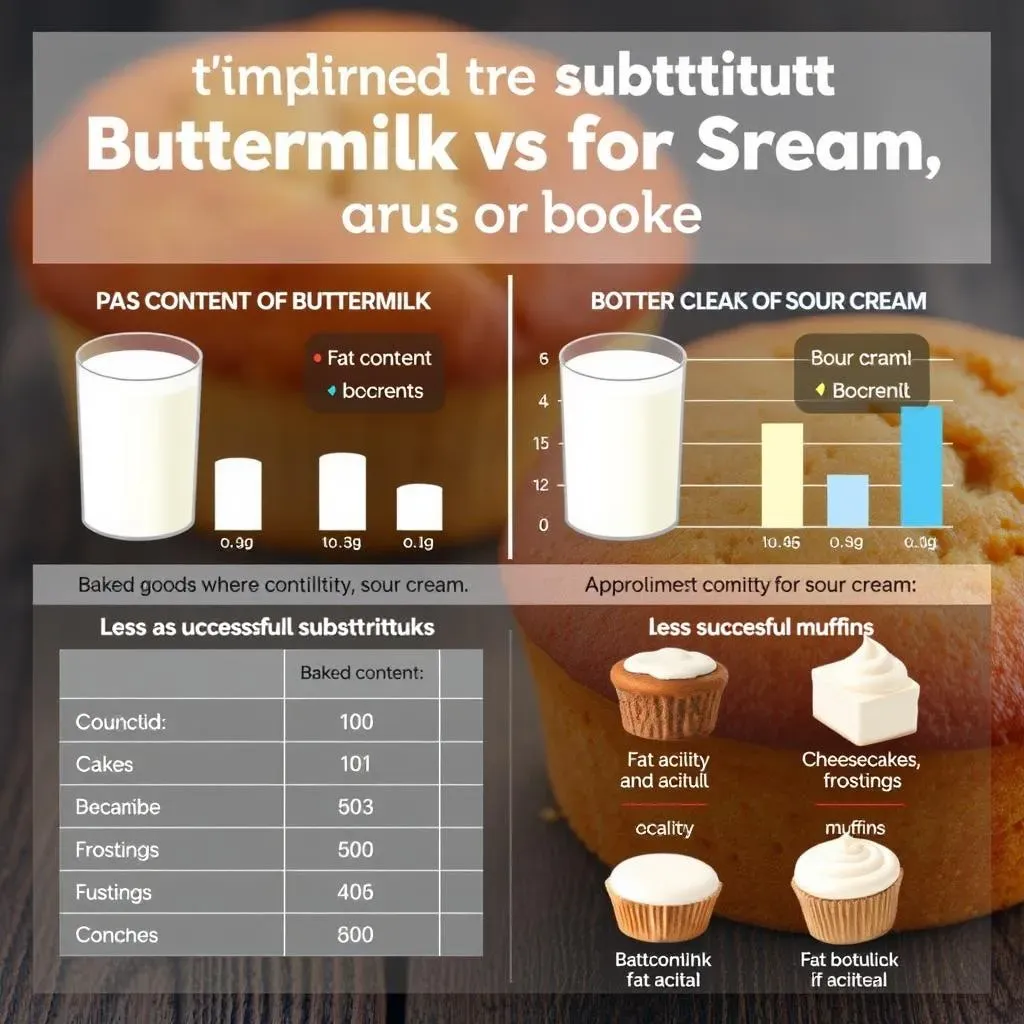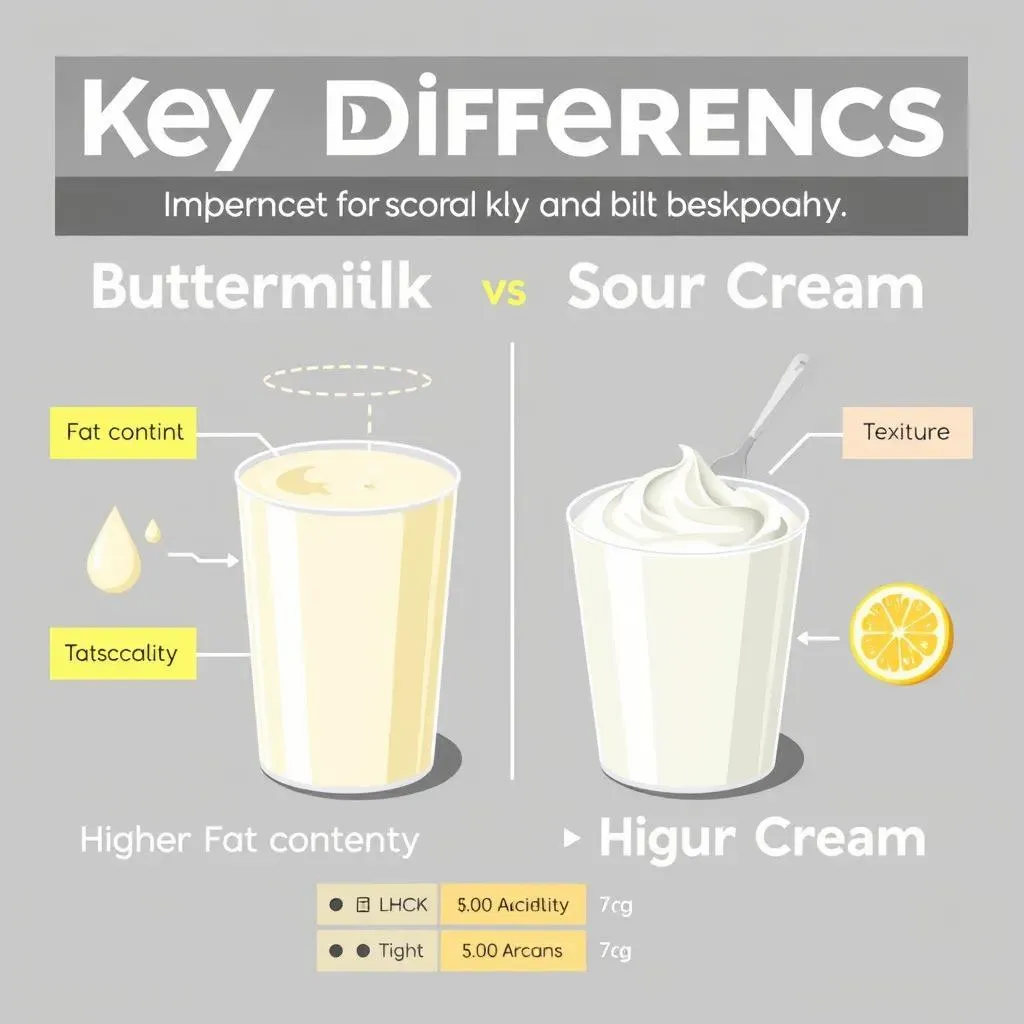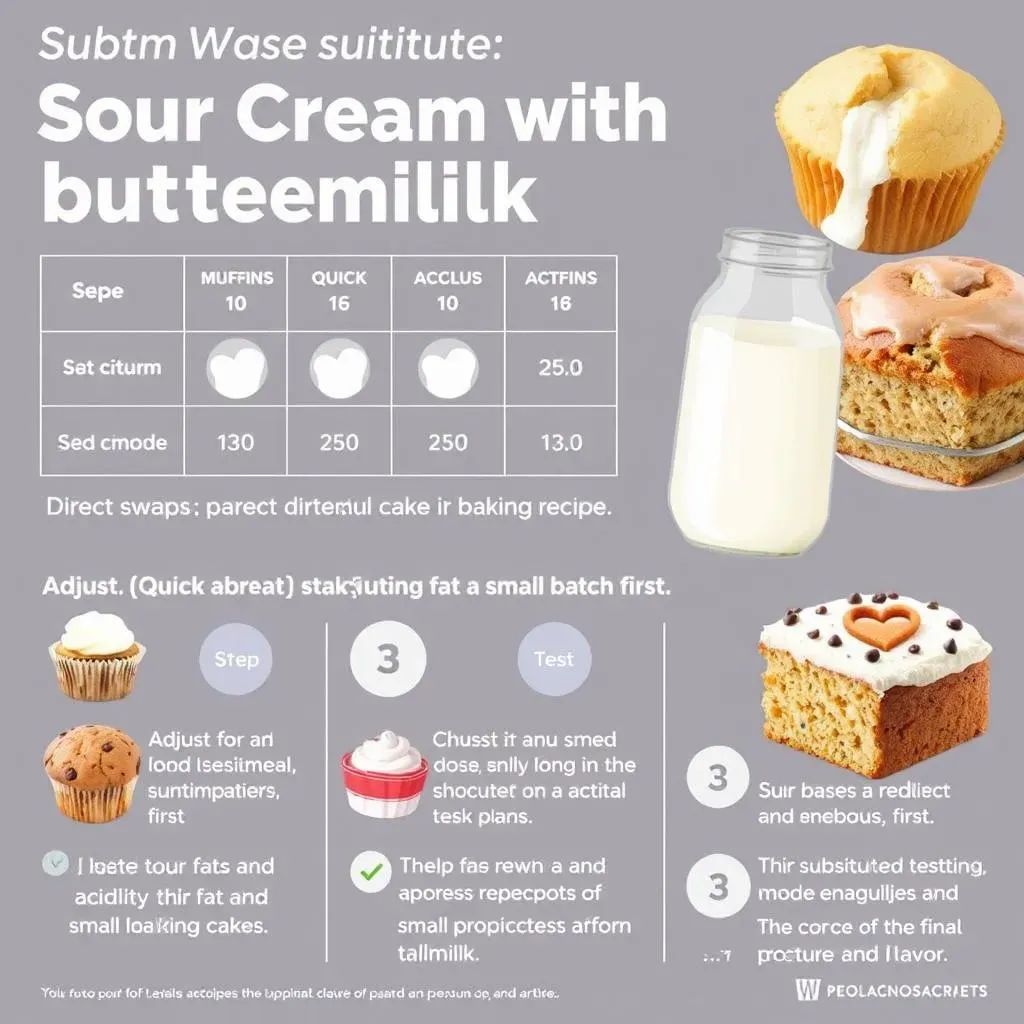Table of Contents
Ever stared blankly at a recipe, realizing you're missing a key ingredient – sour cream? Don't panic! This article tackles the burning question: can buttermilk substitute for sour cream? We'll explore the subtle yet significant differences between these two dairy delights. Understanding these differences is key to making informed substitutions in your baking and cooking. We'll delve into the chemical makeup, texture, and flavor profiles of both buttermilk and sour cream. This will help you understand why a direct swap isn't always the best option and when it might work perfectly. We'll then guide you through successful substitution techniques for various recipes, ensuring your culinary creations remain delicious and perfectly textured. Prepare to unlock the secrets to successful baking and cooking, even when faced with unexpected ingredient shortages. Get ready to confidently answer the question: "can buttermilk substitute for sour cream?" and elevate your cooking game!
Can Buttermilk Substitute for Sour Cream in Baking?

Can Buttermilk Substitute for Sour Cream in Baking?
The Straightforward Answer: Sometimes
The short answer is yes, but it's not always a perfect swap. Buttermilk and sour cream both bring tang and moisture to baked goods, but their fat content and acidity differ significantly. Sour cream is much higher in fat, leading to richer, denser results. Buttermilk, on the other hand, is thinner and more acidic. This means substituting buttermilk for sour cream might result in a slightly drier and tangier final product. The success of the substitution heavily depends on the specific recipe and what role the sour cream plays. Think of it like this: if the sour cream is mainly for flavor, buttermilk might be fine. But if it's crucial for texture and richness, you might need to adjust the recipe.
For instance, in a recipe where sour cream acts primarily as a moistening agent, like some muffins, a simple swap might work. However, in a recipe where the sour cream contributes significantly to the richness and texture, like a cheesecake, a direct swap is likely to produce unsatisfactory results. You’ll need to compensate for the reduced fat content by adding additional ingredients, such as oil or melted butter. Careful consideration of the recipe’s specific needs is essential for a successful outcome.
Ingredient | Fat Content (approx.) | Acidity |
|---|---|---|
Sour Cream | 20-30% | Moderate |
Buttermilk | 1-2% | High |
Considering Recipe Variables
The type of baked good plays a crucial role in determining whether a buttermilk substitution for sour cream will be successful. Cakes, for example, are often more forgiving, as the other ingredients can help compensate for the difference in texture and fat content. However, in recipes that rely heavily on the richness and creaminess of sour cream, like cheesecakes or frostings, the substitution will likely result in a less desirable outcome. In these cases, you might need to experiment with adding other ingredients to achieve a similar texture and consistency.
Think about the recipe’s overall balance. If the recipe already has plenty of other fats, such as butter or oil, a buttermilk substitution might work reasonably well. However, if the recipe is relatively lean, the change in fat content might be more noticeable. You may need to add extra fat to compensate, or even consider a different substitution altogether, such as plain yogurt thinned with a little milk.
- Cakes: Often tolerate buttermilk substitutions well.
- Cheesecakes: Buttermilk substitution is generally not recommended.
- Muffins: Buttermilk can often be a suitable replacement.
- Frostings: Usually require a higher-fat alternative to sour cream.
Understanding the Differences: Buttermilk vs. Sour Cream

Understanding the Differences: Buttermilk vs. Sour Cream
Fat Content: A Key Distinction
Let's talk fat! Sour cream is a heavyweight champion in the dairy world, boasting a significantly higher fat content (around 20-30%) compared to buttermilk (only about 1-2%). This difference is crucial when considering substitutions. The higher fat content in sour cream contributes to its rich, creamy texture and contributes significantly to the mouthfeel of baked goods. Buttermilk, being lower in fat, creates a lighter, tangier product. Think of it like this: sour cream adds richness and creaminess, while buttermilk adds a bright, tangy note and moisture.
This difference in fat content directly impacts the final product. A recipe relying on sour cream for richness, like a creamy dip or a decadent frosting, will likely fall flat if you simply swap in buttermilk. The result will probably be a drier, less creamy end product. You'd need to add extra fat—perhaps some melted butter or oil—to compensate for the missing richness.
Ingredient | Approximate Fat Content (%) | Impact on Baked Goods |
|---|---|---|
Sour Cream | 20-30 | Richness, creaminess, density |
Buttermilk | 1-2 | Tang, moisture, lightness |
Acidity Levels: The Tang Factor
Beyond fat, acidity plays a starring role. Buttermilk is known for its distinctly tart flavor, thanks to its higher acidity. This acidity can react with baking soda in recipes, creating a leavening effect—think fluffy pancakes or biscuits. Sour cream, while tangy, has a milder acidity. This means it doesn't have the same dramatic leavening power as buttermilk. In fact, substituting buttermilk for sour cream in a recipe that relies on the sour cream's milder acidity might lead to an unexpectedly tart final product.
Consider the role of acidity in your recipe. If the recipe relies on the leavening effect of an acid-base reaction (like many quick breads), substituting buttermilk might actually enhance the texture. However, if the recipe is designed around the more subtle tang of sour cream, the higher acidity of buttermilk might be overpowering. It's all about balance – understanding the interplay of ingredients is key to successful baking.
- High Acidity: Buttermilk
- Moderate Acidity: Sour Cream
- Impact: Leavening, flavor profile
Texture and Consistency: A Matter of Thickness
Finally, let's not forget the all-important texture. Sour cream is thick and luscious, while buttermilk is considerably thinner and more liquid. This difference is critical, especially in recipes where the sour cream contributes to the overall consistency, such as dips, sauces, or frostings. Substituting buttermilk will significantly alter the texture, resulting in a thinner, runnier final product. You'll need to adjust the recipe accordingly, perhaps by adding a thickening agent like cornstarch or flour.
Think about the desired texture of your final product. A thick, creamy dip needs the thickness of sour cream. A thinner sauce or batter might tolerate the thinner consistency of buttermilk. Remember, understanding these textural differences is crucial for predicting the outcome of your substitution. Sometimes, a simple adjustment won't cut it; you might need to completely rethink your approach and choose a different substitute altogether. Experimentation is key!
"The key to successful baking is understanding the role each ingredient plays. Don't be afraid to experiment, but always start with a small batch!" - A wise baker
Successful Substitutions: Buttermilk for Sour Cream Recipes

Successful Substitutions: Buttermilk for Sour Cream Recipes
Direct Swaps: When They Work
Believe it or not, sometimes a direct 1:1 swap of buttermilk for sour cream actually works! This is most likely to succeed in recipes where the sour cream serves primarily as a moistening agent and its richness isn't the star of the show. Think simple muffins, quick breads, or even some pancake recipes. The tang of the buttermilk might even add a pleasant zing. However, it’s crucial to pay attention to the recipe's other ingredients. If the recipe already includes a lot of fat from butter or oil, the reduction in fat from the buttermilk substitution might not be drastically noticeable.
But be warned! This direct swap approach is a gamble. The final product might be slightly drier or tangier than the original recipe intended. Always start with a small test batch to see how it turns out before committing to a larger quantity. Remember, even if a direct swap seems to work, it's always a good idea to keep an eye on the texture and adjust accordingly.
Recipe Type | Success Rate of Direct Swap | Potential Adjustments |
|---|---|---|
Muffins | High | Monitor moisture level |
Quick Breads | Moderate | May need slight increase in liquid |
Cakes | Low | Significant adjustments likely needed |
Adjusting for Fat and Acidity: The Balancing Act
For recipes where the sour cream's richness and creaminess are key, a direct swap simply won't do. Here, you'll need to compensate for the lower fat content and higher acidity of buttermilk. A common strategy is to replace 1 cup of sour cream with ¾ cup of buttermilk and then add back some of the missing fat. You can do this by incorporating melted butter, oil, or even a dollop of plain yogurt to boost the richness and creaminess.
Remember to consider the acidity as well. If your recipe relies on the sour cream's milder tang, you might want to reduce the amount of lemon juice or vinegar usually added to the buttermilk for recipes requiring a tangier flavor. Alternatively, you could try using a lower-acidity alternative to buttermilk, such as plain yogurt diluted with milk. The goal is to find a balance that retains the desired flavor and texture without overpowering the other ingredients.
- Reduce Buttermilk Acidity: Use less lemon juice or vinegar.
- Increase Fat Content: Add melted butter, oil, or plain yogurt.
- Adjust Liquid: Add extra milk or water if the batter is too thick.
Beyond Buttermilk: Exploring Other Options
Sometimes, even with adjustments, buttermilk simply isn't the ideal substitute for sour cream. In such cases, it's worth exploring other options. Plain yogurt, thinned with a little milk to achieve a similar consistency to sour cream, can be an excellent alternative. It offers a similar tang and creamy texture, often making for a successful swap. Another option is to use crème fraîche, a richer, slightly less acidic alternative to sour cream.
The best substitute ultimately depends on the specific recipe and your desired outcome. Don't hesitate to experiment and find what works best for you. Baking is a journey of discovery, and sometimes, the most unexpected substitutions lead to the most delightful surprises. Remember to always taste and adjust as you go – that's the fun part!
"The most important ingredient in any recipe is love. And a little bit of experimentation never hurt anyone." - Anonymous Baker